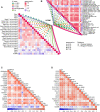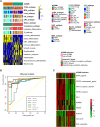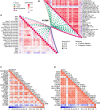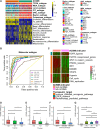ACSM6 overexpression indicates a non-inflammatory tumor microenvironment and predicts treatment response in bladder cancer: results from multiple real-world cohorts
- PMID: 37426827
- PMCID: PMC10323142
- DOI: 10.3389/fphar.2023.1222512
ACSM6 overexpression indicates a non-inflammatory tumor microenvironment and predicts treatment response in bladder cancer: results from multiple real-world cohorts
Abstract
Background: ACSMs play critical roles in lipid metabolism; however, their immunological function within the tumor microenvironment (TME) remains unclear, especially that of ACSM6. In this study, we investigate the latent effect of ACSM6 on bladder cancer (BLCA). Methods: Several real-world cohorts, including the Xiangya (in-house), The Cancer Genome Atlas (TCGA-BLCA), and IMvigor210 cohorts, with TCGA-BLCA cohort serving as the discovery cohort were compared. We investigated the potential immunological effects of ACSM6 in regulating the BLCA tumor microenvironment by analyzing its correlation with immunomodulators, anti-cancer immune cycles, immune checkpoints, tumor-infiltrating immune cells, and the T-cell inflamed score (TIS). Additionally, we assessed the precision of ACSM6 in predicting BLCA molecular subtypes and responses to several treatments using ROC analysis. To ensure the robustness of our findings, all results were confirmed in two independent external cohorts: the IMvigor210 and Xiangya cohorts. Results: ACSM6 expression was markedly upregulated in BLCA. Our analysis suggests that ACSM6 might have significant impact to promote the formation of a non-inflamed tumor microenvironment because of its negative correlation with immunomodulators, anticancer immune cycles, immune checkpoints, tumor-infiltrating immune cells, and the T-cell inflamed score (TIS). Additionally, high ACSM6 expression levels in BLCA may predict the luminal subtype, which is typically associated with resistance to chemotherapy, neoadjuvant chemotherapy, and radiotherapy. These findings were consistent across both the IMvigor210 and Xiangya cohorts. Conclusion: ACSM6 has the potential to serve as a valuable predictor of the tumor microenvironment phenotypes and treatment outcomes in BLCA, thereby contributing to more precise treatment.
Keywords: ACSM6; bladder cancer; chemothearpy bladder cancer; chemotherapy; immunotherapy; tumor microenvironment.
Copyright © 2023 Li, Yao, Qi, Wu, Deng and Liu.
Conflict of interest statement
The authors declare that the research was conducted in the absence of any commercial or financial relationships that could be construed as a potential conflict of interest.
Figures








Similar articles
-
ACER2 forms a cold tumor microenvironment and predicts the molecular subtype in bladder cancer: Results from real-world cohorts.Front Genet. 2023 Mar 1;14:1148437. doi: 10.3389/fgene.2023.1148437. eCollection 2023. Front Genet. 2023. PMID: 36936425 Free PMC article.
-
GATA3 Predicts the Tumor Microenvironment Phenotypes and Molecular Subtypes for Bladder Carcinoma.Front Surg. 2022 May 12;9:860663. doi: 10.3389/fsurg.2022.860663. eCollection 2022. Front Surg. 2022. PMID: 35647011 Free PMC article.
-
Siglec15 shapes a non-inflamed tumor microenvironment and predicts the molecular subtype in bladder cancer.Theranostics. 2021 Jan 1;11(7):3089-3108. doi: 10.7150/thno.53649. eCollection 2021. Theranostics. 2021. PMID: 33537076 Free PMC article.
-
CD93 orchestrates the tumor microenvironment and predicts the molecular subtype and therapy response of bladder cancer.Comput Biol Med. 2022 Aug;147:105727. doi: 10.1016/j.compbiomed.2022.105727. Epub 2022 Jun 29. Comput Biol Med. 2022. PMID: 35785664
-
Overexpression of MTHFD2 represents an inflamed tumor microenvironment and precisely predicts the molecular subtype and immunotherapy response of bladder cancer.Front Immunol. 2023 Dec 7;14:1326509. doi: 10.3389/fimmu.2023.1326509. eCollection 2023. Front Immunol. 2023. PMID: 38130721 Free PMC article.
Cited by
-
Oncogenic ACSM6 impairs CD8+ T cell-based immune response in bladder cancer.Biomark Res. 2024 Sep 27;12(1):112. doi: 10.1186/s40364-024-00657-y. Biomark Res. 2024. PMID: 39334304 Free PMC article.
References
LinkOut - more resources
Full Text Sources

